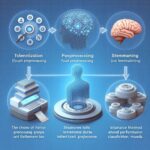Introduction
ChatGPT is a natural language processing (NLP) tool that helps developers build intelligent chatbot applications. It utilizes supervised learning, unsupervised learning, and reinforcement learning to understand natural language and generate intelligent responses. In this article, we will discuss the differences between supervised learning, unsupervised learning, and reinforcement learning in ChatGPT, as well as the advantages and disadvantages of each. We will also provide code examples to illustrate how each type of learning can be used in ChatGPT.
What is Supervised Learning?
Supervised learning is a type of machine learning that uses labeled data sets to train algorithms. In supervised learning, the algorithm is given a set of labeled data and is tasked with learning the relationship between the input data and the desired output. This type of learning is useful for tasks such as classification, prediction, and regression. In ChatGPT, supervised learning can be used to create a chatbot that can understand natural language and generate intelligent responses.
Unsupervised Learning Explained
Unsupervised learning is a type of machine learning that uses unlabeled data sets to train algorithms. Unlike supervised learning, unsupervised learning does not require a labeled data set. Instead, the algorithm is given an unlabeled data set and is tasked with finding patterns and relationships in the data. This type of learning is useful for tasks such as clustering, anomaly detection, and data compression. In ChatGPT, unsupervised learning can be used to create a chatbot that can understand natural language and generate intelligent responses.
Reinforcement Learning Basics
Reinforcement learning is a type of machine learning that uses rewards and punishments to train algorithms. In reinforcement learning, the algorithm is given an environment and is tasked with learning the best way to interact with the environment in order to maximize rewards and minimize punishments. This type of learning is useful for tasks such as robotics, game playing, and autonomous navigation. In ChatGPT, reinforcement learning can be used to create a chatbot that can understand natural language and generate intelligent responses.
Supervised Learning & ChatGPT
In ChatGPT, supervised learning can be used to create a chatbot that can understand natural language and generate intelligent responses. To do this, the developer must provide a labeled dataset of conversations that the chatbot can use to learn the relationships between different words and phrases. Once the chatbot has been trained on the dataset, it can then generate intelligent responses to new conversations.
Unsupervised Learning & ChatGPT
In ChatGPT, unsupervised learning can be used to create a chatbot that can understand natural language and generate intelligent responses. To do this, the developer must provide an unlabeled dataset of conversations that the chatbot can use to learn the relationships between different words and phrases. Once the chatbot has been trained on the dataset, it can then generate intelligent responses to new conversations.
Reinforcement Learning & ChatGPT
In ChatGPT, reinforcement learning can be used to create a chatbot that can understand natural language and generate intelligent responses. To do this, the developer must provide an environment in which the chatbot can interact and learn from rewards and punishments. Once the chatbot has been trained on the environment, it can then generate intelligent responses to new conversations.
Advantages of Supervised Learning
The main advantage of supervised learning is that it is relatively easy to implement and requires less data than unsupervised learning. Supervised learning also produces more accurate results than unsupervised learning, as the labeled data set provides the algorithm with a “ground truth” that it can use to make more accurate predictions.
Benefits of Unsupervised Learning
The main benefit of unsupervised learning is that it requires less labeled data than supervised learning. Unsupervised learning can also produce more accurate results than supervised learning, as the algorithm is able to find patterns and relationships in the data that may not be evident in the labeled data set.
Reinforcement Learning Benefits
The main benefit of reinforcement learning is that it is able to learn from its environment in real time. This makes it useful for tasks such as robotics and autonomous navigation, where the environment is constantly changing. Reinforcement learning also requires less data than supervised and unsupervised learning, as it is able to learn from rewards and punishments.
Limitations of Supervised Learning
The main limitation of supervised learning is that it requires a large amount of labeled data in order to produce accurate results. This can be costly and time consuming to produce, and can limit the scalability of the model. Supervised learning also does not allow the algorithm to learn from its environment in real time, which can limit its usefulness for tasks such as robotics and autonomous navigation.
Disadvantages of Unsupervised Learning
The main disadvantage of unsupervised learning is that it can be difficult to interpret the results, as the algorithm is not given a “ground truth” to compare its predictions to. Unsupervised learning also requires a large amount of data in order to produce accurate results, which can limit its scalability.
Challenges of Reinforcement Learning
The main challenge of reinforcement learning is that it can be difficult to define rewards and punishments that are appropriate for the task at hand. If the rewards and punishments are not defined correctly, the algorithm may not be able to learn the desired behavior. Reinforcement learning also requires a large amount of data in order to produce accurate results, which can limit its scalability.
Differences Between Supervised Learning, Unsupervised Learning and Reinforcement Learning in ChatGPT in Summary
In summary, supervised learning, unsupervised learning, and reinforcement learning are all types of machine learning that can be used in ChatGPT to create a chatbot that can understand natural language and generate intelligent responses. Supervised learning requires a labeled dataset and produces more accurate results than unsupervised learning, but requires more data. Unsupervised learning does not require a labeled dataset and can produce more accurate results than supervised learning, but is more difficult to interpret. Reinforcement learning requires an environment and can learn from rewards and punishments in real time, but can be difficult to define rewards and punishments.












